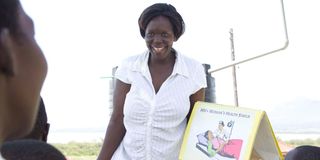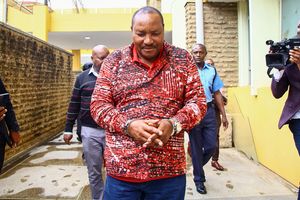Premium
To tell or not? Tough choices of raising HIV+ children on drugs

A health worker conducts a HIV/Aids education session during a support group meeting for pregnant and lactating mothers.
When Kevin Kibet* was born in 2016, he weighed 3.8 kilogrammes. Weeks later, he started weighing less. His mother shunned breastfeeding her first-born and it took much pressure from relatives for her to reluctantly do so.
Like the pregnancy she concealed until it was no longer tenable to hide, there was some veil of secrecy around her and her son that was a mystery.
But, when she died in 2020, it became clear why she was being so protective of her son. She was HIV positive and so was he.
“His health started deteriorating; he became thin, would diarrhoea frequently and, at the age of two, he was not walking. Something was amiss,” recalls Kibet’s aunt who now takes care of the six-year-old boy.
She recalls that, when the boy turned five, his health worsened. One day, there was an HIV/Aids seminar near her home.
“I attended that seminar and doctors were teaching mothers about the symptoms. I later went to a pharmacy, I was scared for him and I never thought my child was HIV positive. They tested him then the doctor told me he was reactive,” she recalls.
The boy turns seven in March and they are following up with routine medical check-ups. He started to take the medication in 2021. David Nyongesa*, 9, runs to greet us and then rushes to the house to call his mother. A jovial and respectful boy despite his HIV status.
The question that lingers in Agnetta Nyongesa’s* mind is the right time to disclose to her son his status. She recalls a day when the boy asked a question that caught her off-guard. It stemmed from the drugs that the boy has to take daily.
“I remember his exact words after he came from school; ‘Mum niko na Ukimwi [Am I HIV positive]? I was shocked, I knew something had happened and, while it tore me apart, I said: ‘No, you don’t.’ I talked to him and he was okay and I later went to his school to talk to his teacher.”
“Sometimes I feel like that was the right time for me to tell him. I want him to have a normal childhood, he just knows he has a condition that we are treating but does not know what exactly. I don’t want him to lose his confidence and his self-esteem,” she says. According to Ms Nancy Nyaboke Oigara, a registered clinical officer at Olenguruone Sub-county Hospital, it’s important to consider how the child will react and what they will want to know based on their age and maturity.
“There are two types of HIV patients; those from 0-9 years but who sometimes extend to 12 years. They only need to understand that they are taking drugs but not what for. Then we have children above twelve years who need to understand what kind of medication they are taking,” Ms Moraa explains.
“In our facility, the mother-to-child transmission has decreased and, in 2022, out of 25 mothers with the virus, only one child turned out positive,” Ms Oigara discloses.
According to the World Aids Day report 2022, Kenya recorded an increase in new HIV infections for the first time in a decade with more than 2,000 cases. The cases rose from 32,025 to 34, 540.
The report attributes the increase to new HIV infections among children, adolescents and younger people and the shortage of HIV drugs. It revealed that, of the 34,540 new cases, 70 per cent (20,505) occurred among women and girls. It also reported that 52 per cent of all new infections occurred among adolescents and young adults aged 15-29 years.





